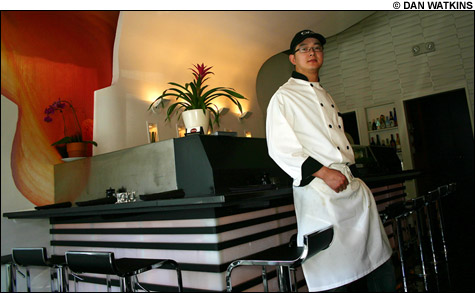
SERIOUS CHEF: The atmosphere may be whimsical, but Gari Huang’s sushi is no laughing matter. |
There are only, what, 452 sushi bars within three blocks of Coolidge Corner? So when Niko’s lost its lease, what replaced the small Greek restaurant? An even smaller sushi bar, of course — although this one has some cooked dishes, and a menu of fusion entrées with starch, protein, and vegetables. Another noticeable difference between Gari and its competitors is that this new space has a sort of club atmosphere, with flashing lights; ambient electronica; a red, black, and white color scheme; even a cool bathroom. That’s an awful lot of atmosphere crammed into a tiny storefront. I sat down thinking, “They better have the food to back this up, or I’m going to write a very funny column.” But I like the food, so we’ll save the décor jokes for the next over-the-edge South End bistro.
Chef Gary Huang’s specialties are mostly custom maki, but we started with appetizers. He does a nice if traditional job with agedashi bean curd ($6), which is fried cubes with a fuzzy coating, stacked in thin fish stock with tiny gelatinous mushrooms. If one of the ideas of Japanese food is to slow you down to a meditative experience, these mushrooms — which are impossible to pick up with chopsticks — are kind of a punctuation of that idea. Much easier to eat is the edamame ($5), which are nicely underdone green soybeans in the shells, not over-salted, each a burst of flavor in your mouth.

Wok-fried calamari ($10) was our first brush with Gari’s fusion concepts. These are large squid rings with spices in the breading, and a field-greens salad stuffed into a pile of rings. There’s a bit of a lemongrass-chili condiment, but the rings are nicely spiced already. A tempura appetizer was familiar but impeccable: three split shrimp breaded and fried into batons; slices of zucchini, sweet potato, squash, and shitake mushroom were done likewise.
Okay, maki time! We set up about three dinners’ worth of food. The first of those many dinners was vegan, with kappa ($3.50), which is cucumber, avocado ($3.50 on its own), and asparagus ($3.50 on its own). To provide some protein, we added a sweet egg omelet ($4/sushi; $5.50/sashimi). I like it when someone orders these simple dishes because they test the basics of the kitchen, which, in a sushi restaurant, always come down to the quality of the sushi rice and the seriousness of the chef. Chef Huang doesn’t neglect basic maki and rolls them tightly. Plus, the rice is fresh and sweet. You can linger on the contrasting tastes of the raw asparagus’s green flavor and the dry flavor of the algal seaweed nori that it’s rolled in. Or you can linger on the richness of the avocado in this context. I also rather like that the egg omelet is not overly sweet.
Moving up, we made another dinner of “fashion maki” ($7) and “Alaska maki” ($6). I’m unclear why it’s called fashion maki. Maybe it’s a pun on fusion, since it combines the rich morsels of its three main ingredients: Japanese-style broiled eel, European cream cheese, and avocado, originally from Mexico. (It also contains cucumber.) The net flavor is a rich melding of fish and cream cheese. “Alaska maki” is made with king salmon, which ought to taste leaner and meatier than farmed salmon, but is affected by avocado and bonito flakes in the mix. As a result, the net flavor is not unlike lox and bagels.
For seriously creative maki, there is a special list with items such as King Cobra ($16). You might expect bite, but the snake aspect comes from the appearance of a round roll (crab and avocado) with a length of broiled eel on top, crowned with golden tobiko (fish eggs as large and flavorful as osetra caviar) and bits of edible gold leaf. Also on the special list is an elaborate version of spicy scallop maki ($14). These are large spiral inside-out rolls topped with black caviar and chili paste, with spices and slices of raw scallop inside. I preferred the tame cobra to the scallops that fought back, but both were excellent.
In order to sample the large plates, we tried the grilled chicken ($18). This is a bistro-looking platter with nicely done grilled chicken breast that was sliced thin and reassembled over a Thai-style green curry of potato fingers, artichoke hearts, and grilled pineapple — an old friend from the East Coast Grill. There was also a bowl of Thai jasmine rice, made sticky like the Japanese short-grain variety, which was pretty good.
Gari has a short list of wines, a better list of bottled Japanese beers, and a fine mid-length list of different styles of sake.
There are two desserts, both impressive. Green-tea mousse cake ($6.95) is an exquisitely made little cylinder with four layers of mousse and thin-sliced cake, and another cake wrapped around and decorated with lines and dots. Unfortunately for some, the mousse retains the slightly fishy flavor of fine green tea. Crème brûlée ($8) is a classic version, with a very slight granularity and also a slice of kiwi.